Suzuki Swift (2010-2017) Review
Written by Andrew Brady
Quick overview
Pros
- Well-equipped across the range
- Great fun to drive, in and out of the city
- Excellent value for money
Cons
- Lacks overall refinement
- Ride quality is a little on the firm side
- Small boot for the size of car
Overall verdict
"The Suzuki Swift deserves to be on your supermini shortlist. It looks good if you opt for one of the trim levels with alloy wheels and some cosmetic upgrades, while the fun-to-drive dynamics are an unexpected bonus. You’ll also appreciate the low running costs and the high level of standard equipment."
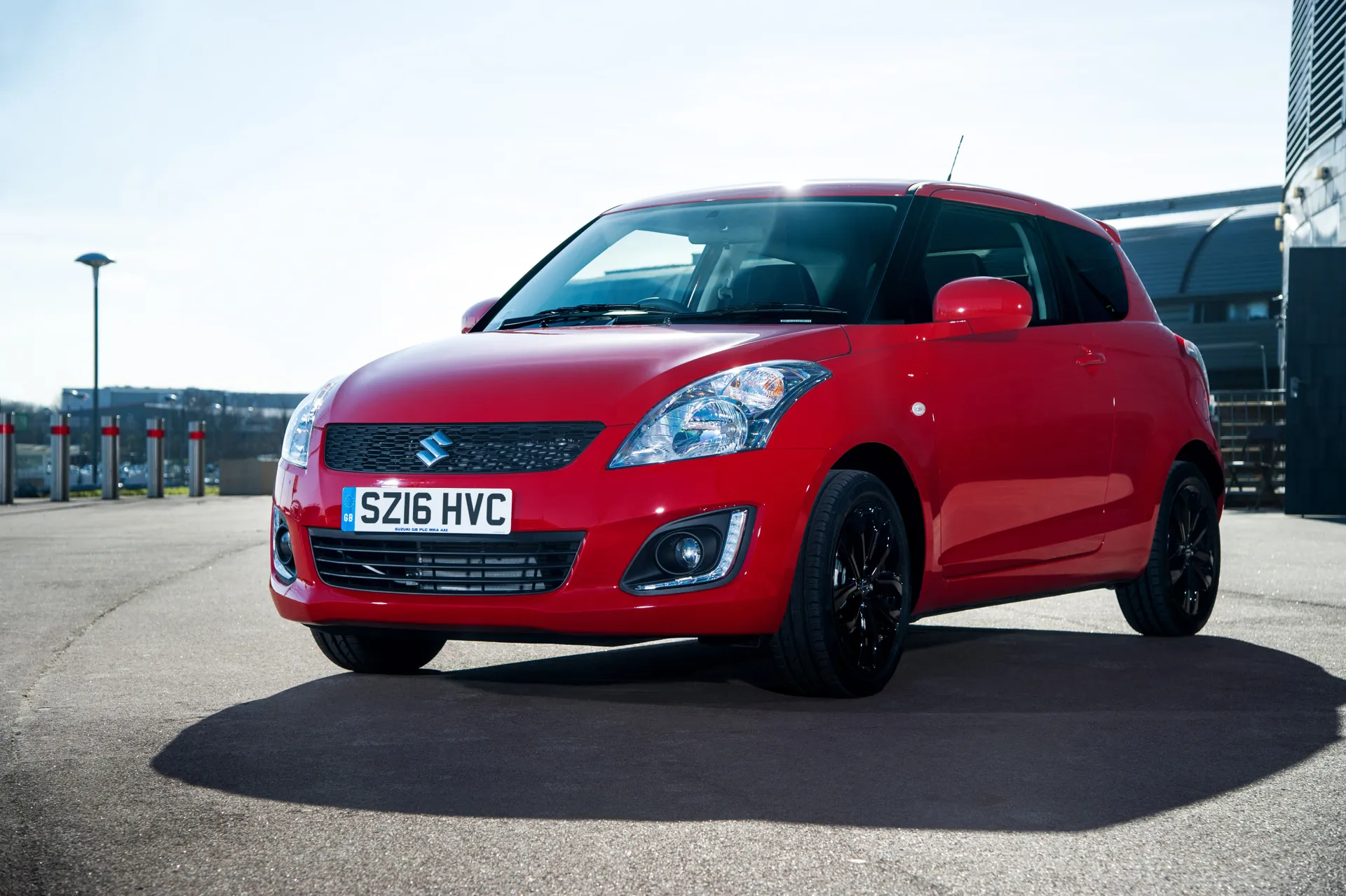
If we asked you to name five famous small hatchbacks, what would you say? Ford Fiesta, Vauxhall/Opel Corsa, Renault Clio, Honda Jazz and Peugeot 208, perhaps? It’s like trying to name five famous Belgians."
The Suzuki Swift doesn’t come from Belgium, but it’s one of the best small cars you can buy. Not only is it great to drive, but it also packs a long list of standard equipment, some efficient engines and a reliability record that’s better than most.
When we say the Swift is great to drive, we mean it, because the little Suzuki is nipping at the ankles of the Ford Fiesta when it comes to enjoyment. The 1.2-litre petrol engine in the standard Swift is a buzzy and rev-happy unit, while the 1.6 engine in the Swift Sport delivers junior hot hatchback levels of fun.
There’s also the option of a 1.3-litre diesel engine if you demand excellent fuel economy, along with a 4x4 version if your daily commute includes greasy roads and green lanes. There’s something for everyone, including the option of three or five doors.
The light controls make it an easy car to drive in the city, but the Swift is also terrific fun on a country road, boasting sharp steering, keen handling and virtually no body-roll. The ‘wheel-at-each-corner’ stance makes it feel like a Mini or the original Ford Ka. That’s high praise.
The flip-side to the keen handling is a ride quality that’s overly firm, which is especially noticeable on larger alloy wheels and particularly pock-marked roads. The steering is also too light to inspire a huge amount of confidence when cornering.
Then there’s the issue of practicality, with the Suzuki Swift offering the kind of luggage capacity more familiar to city car drivers. It’s fine for a short break, but try packing for anything longer than a weekend and you’ll be searching for the number of the nearest car rental firm.
Some people may also point to the drab interior as a reason to avoid the Swift. However, while it’s true that it lacks flair and the range of personalisation options we’ve grown accustomed to in 2020, the cabin does feel robust and built to last.
You also get a long list of standard equipment, although the absence of air conditioning on the entry-level Swift means that you’ll be tempted to upgrade to the mid-range model. That’s fine, because given the age of the car, even flagship models are within easy reach of anyone with a strict budget.
It’s a terrific little supermini that’s as fun to drive as a Fiesta or a Mini, boasts an impressive Euro NCAP safety rating and is packed with equipment. It might not be the most obvious choice, but popular appeal doesn’t always translate to greatness.
As for five famous Belgians, take the names Audrey Hepburn, Hergé, Jean-Claude Van Damme, René Magritte and Kevin De Bruyne to the next pub quiz.
If you're looking for the newer version, you need our Suzuki Swift (2017-) review.
Is the Suzuki Swift right for you?
The Suzuki Swift might not be the first car that springs to mind when you’re considering your next supermini, but it should definitely be on your shortlist. It’s almost as agile as a Ford Fiesta, smarter looking than the equivalent Vauxhall Corsa, and offers more toys as standard than many rivals.
If you enjoy driving, you’ll love the Swift. It greets roundabouts, congested streets and tight corners like a dog greets a ball, but it’s also good fun to drive on the open road.
It also comes in many different flavours, including three-door, five-door, petrol, diesel, Sport and 4x4. Indeed, the Suzuki Swift Sport is one of our favourite hot hatchbacks, while the Swift 4x4 is perfect if you live in a rural area or your daily commute includes a rutted track or green lane.
What’s the best Suzuki Swift model/engine to choose?
The Suzuki Swift Sport is a barrel of laughs. By rights, it should be our recommended version of the Suzuki Swift, but it’s not, because the standard Swift with a 1.2-litre petrol engine does everything so well.
It’s a willing engine that thrives on revs – the peak output of 94PS comes at 6,000rpm – so it’s a huge amount of fun in the city and on a country lane. Sure, it sounds a bit coarse when you really push it, but this is a small price to pay for such thrills. In the Honest John Real MPG test, it delivered a credible 50.5mpg, which is only 6mpg short of the claimed figure.
As for the trim level, although the entry-level version is well-equipped, we’d recommend the mid-range SZ3, not least because it features air conditioning, Bluetooth and alloy wheels. Oh, and the five-door is superior to the three-door, as it makes better use of the Swift’s excellent rear-seat accommodation.
What other cars are similar to the Suzuki Swift?
The list of cars similar to the Suzuki Swift includes some household names. The Ford Fiesta, Vauxhall/Opel Corsa and Renault Clio are three of the biggest selling cars in Europe, but the Swift also rivals the Peugeot 208, Hyundai i20, Kia Rio, Volkswagen Polo, Skoda Fabia, Citroen C3, Seat Ibiza, Toyota Yaris, Honda Jazz and Mazda 2.
Of these, the Ford Fiesta and Mazda 2 are the most similar from a driving perspective, while the Skoda Fabia offers a similar level of value for money. Not many rivals can offer a hot hatchback variant and a 4x4, mind.
Comfort and design
"If you’re a fan of soft-touch plastics, personalisation options or a splash of colour, the Suzuki Swift isn’t for you. The dashboard, door cards and centre console are swathed in grey plastic, with just a few hints of silver plastic to lift the mood."
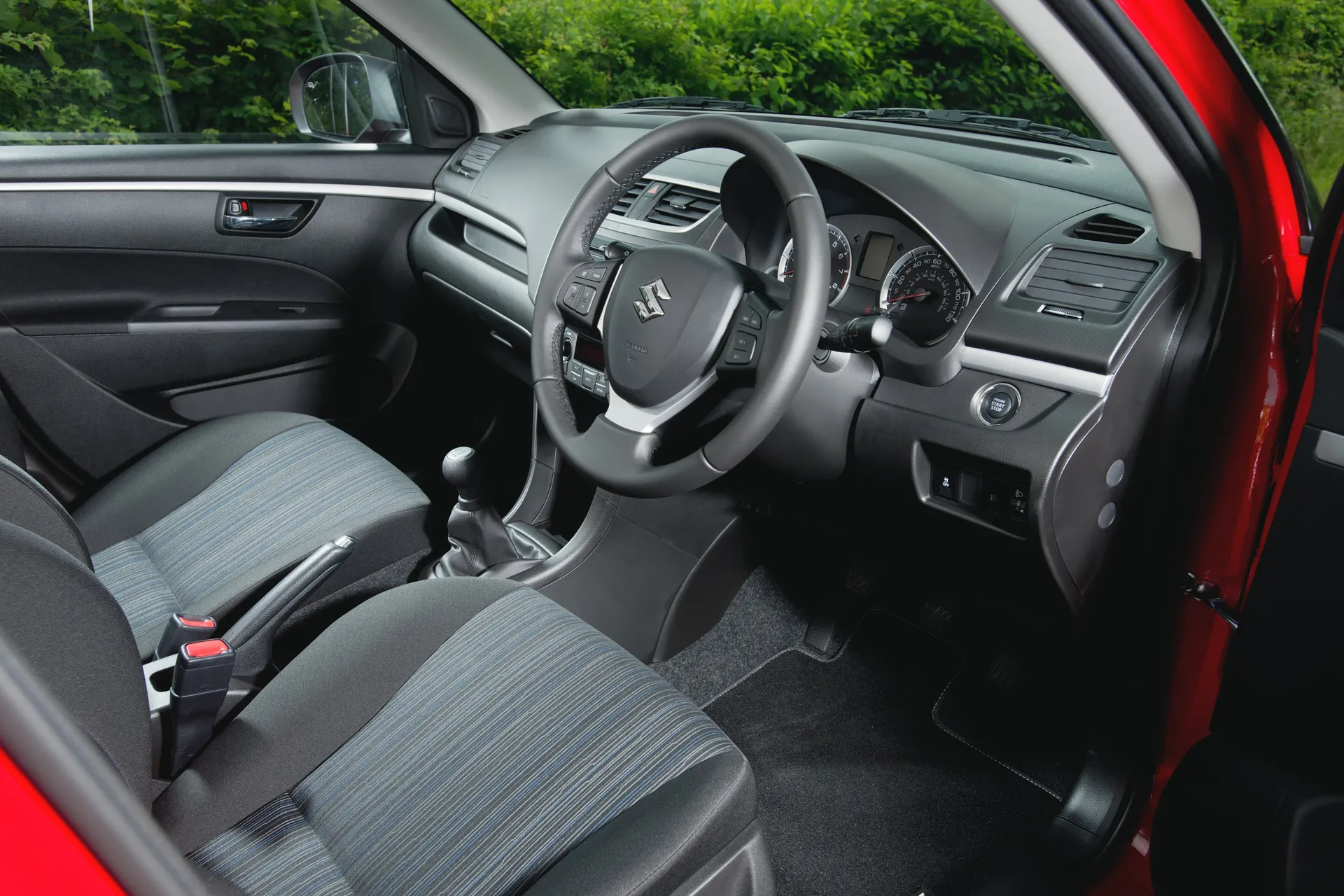
It’s all very predictable, which might not be a bad thing, depending on what you look for in a car. It’s a clear and logical layout, with two circular dials in the instrument panel, simple-to-use heater/air conditioning controls, an audio system in the centre of the dashboard and electric window controls on the doors.
Getting comfortable shouldn’t be a problem as all versions come with a height-adjustable steering wheel. However, while all get a leather steering wheel that’s adjustable for height, reach adjustment is only available on the higher trim levels. This could be crucial for taller drivers.
There are a couple of ways to lift the interior ambience. For example, the SZ-L, introduced in 2014, features silver stitching on the steering wheel, gear lever gaiter and seats, along with a bespoke fabric design for the seats. It’s not much, but it helps.
Alternatively, the Swift Sport offers by far and away the best interior. The sporty seats do a better job of holding you in place when you’re making the most of the, ahem, swift performance, while red stitching on the seats, steering wheel and gear lever gaiter delivers a racy feel. You also get stainless steel pedals.
Quality and finish
The bland interior is matched by a range of materials that feel cheap and rooted in the bottom end of the market. However, you need to remember that the Swift dates back to 2010, so it lags behind modern rivals.
Besides, although the plastics feel cheap, they’re actually pretty robust and hard-wearing. The Swift’s biggest problem is that the dashboard and door plastics feel hollow when you knock on them. The cure: don’t knock on ’em.
Look beyond the cheap plastics and you’ll discover a cabin that’s surprisingly upmarket in terms of specification. A leather-covered steering wheel with audio controls is standard across the range, while air conditioning is fitted to all except the entry-level version.
It’s the little things you’ll notice, like the flimsy carpet in the boot, the cheap fabric used on the backs of the rear seats, plus the low-rent levers for adjusting the front seats and lowering the rear bench.
Predictably, the Swift Sport has the most upmarket feel, but it’s more a question of raised perceived quality rather than actual quality.
Infotainment
Entry-level versions of the Suzuki Swift come with a radio, CD player, USB socket, four speakers and a pair of tweeters. It’s basic in the extreme, but it’s neatly integrated in the centre console and easy to use when on the move.
Early flagship models featured a Pioneer multimedia unit with phone connectivity and satellite navigation, but a newer aftermarket system would make more sense in 2020. Buyers of other trim levels could opt for one of two Pioneer units, but they were an expensive upgrade on a car at the budget end of the market.
DAB digital radio and satellite navigation became standard on the Swift Sport in 2014. It’s also worth finding the updated version of the SZ-L special edition, introduced in 2016. Highlights include DAB digital radio, satellite navigation, cruise control and cosmetic upgrades to give it the look of the Sport.
Space and practicality
When it comes to practicality, the Suzuki Swift is a bit of a mixed bag. Let’s get the negatives out of the way first.
The boot is far too small. A figure of 211 litres might be meaningless in isolation, so you need to consider the size of some of the Swift’s rivals. You’ll find 290 litres of luggage capacity in the current Ford Fiesta. There’s 309 litres in the Vauxhall Corsa, while the all-new Renault Clio boasts up to 391 litres of space, depending on the engine.
Admittedly, these are newer cars than the Swift we’re focusing on here, but even the latest Swift boasts 264 litres of space. You’ll need to get used to travelling light.
More positive is the fact that the rear seats fold 60/40, but while this is useful, the fact that they don’t fold anywhere near flat will pose some loading questions when you’re outside a Swedish furniture store armed with a trolley full of boxes.
It’s not all bad news. The rear seats offer plenty of legroom and headroom, helped in no small part by the high roofline. This is the flipside of having a small boot in a supermini – you can’t have everything, unless you buy a Honda Jazz or a Nissan Note.
There are three cupholders in the cabin, along with a decent size glovebox, a covered tray atop the dashboard, a deep storage area at the bottom of the centre console, pockets with bottle holders in each door, and a central storage bin. There’s also a tray in front of the passenger, but this is of little use beyond carrying pens or sweets.
The five-door version is more practical than the three-door, especially if you’re strapping a child into a car seat. There are Isofix points in the back, along with childproof rear door locks in the five-door model.
In 2013, Suzuki launched a five-door version of the Swift Sport, along with the new five-door 4x4.
Handling and ride quality
"The Suzuki Swift might not offer class-leading levels of practicality, but it’s close to the top when it comes to the driving experience. We’ve enjoyed many good drives in the basic 1.2-litre Swift, which offers near-Fiesta levels of fun."
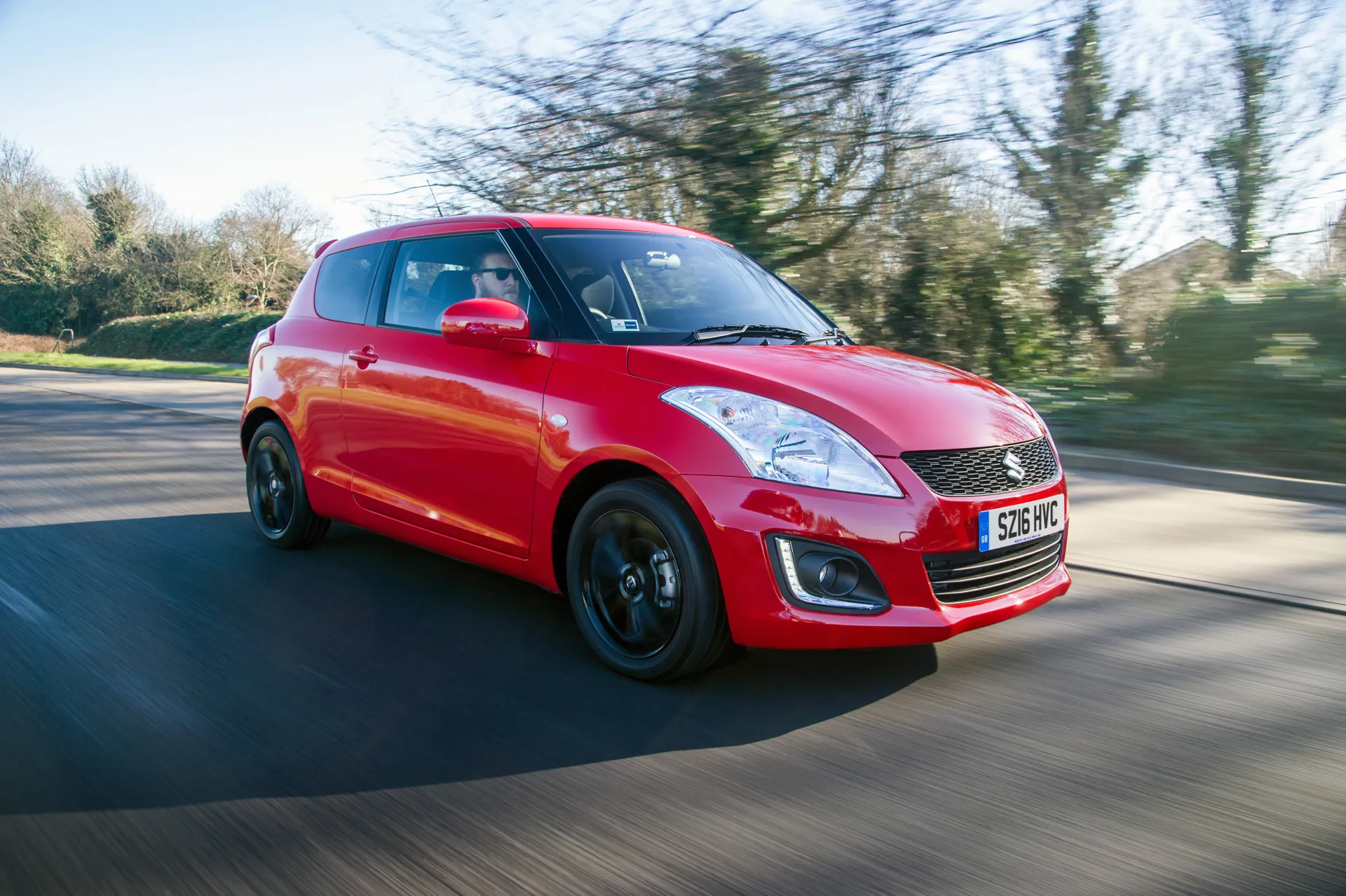
Although we hate to use the phrase ‘go-kart handling’ to describe any car, it kind of sums up the way the Swift feels. It’s the way it changes direction that’s most impressive, with the agility and nimbleness of the Swift presenting a welcome tonic to the bloated and ungainly compact crossovers of today.
Crucially, it’s great to drive in and out of the city. The light controls make it easy to drive and park, while the sharp steering and absence of body-roll make it a joy to drive on a country lane. It’s so good, you’ll question the need for the Swift Sport. We’ll come to that in a moment.
In the meantime, let’s explore the shortfalls of the Swift. First, the steering is too light, which makes the Swift less satisfying to drive than the Ford Fiesta. Then there’s a ride quality, which lacks the suppleness you’ll find in some rivals. It’s uncomfortable on poorly surfaced roads and you’ll want to avoid potholes and drain covers.
Things improve with the Suzuki Swift 4x4, because its 25mm increase in body height makes the ride slightly more comfortable, while the permanent four-wheel-drive system inspires more confidence when cornering.
However, the Swift Sport is the most enjoyable car to drive. Few superminis offer such a thrilling driving experience, with the revvy engine combining with a tight chassis and a rorty exhaust note to make it feel faster than the on-paper figures would suggest.
It rides very well for a hot hatchback, which is impressive given the 17-inch alloy wheels and low-profile tyres. It also changes direction like a housefly, although we’d like a little more feedback from the steering and a more satisfying six-speed manual gearbox.
Engines and gearboxes
If you’ve been paying attention, you’ll know that we’re fans of the 1.2-litre petrol engine. Although it produces just 94PS and 118Nm of torque, it thrives on revs, which makes it a joy to push to the redline. A 0-62mph time of 12.3 seconds might seem slow, but in reality it feels more rapid.
This figure is based on the manual gearbox. Opt for the automatic and the 0-62mph time increases to 13.5 seconds, the driving experience becomes more frustrating, and you’ll be wishing you opted for the manual.
The Swift 4x4 uses the same 1.2-litre engine, but the extra weight of the four-wheel-drive system creates a leisurely 0-62mph time of 13.4 seconds.
There was a 1.3-litre DDiS diesel engine available, which offered excellent on-paper economy. A top speed of 103mph was in-line with the petrol engine, but the 0-62mph time increased to 12.7 seconds. Unless you need the long-legged economy, we’d avoid the diesel engine. It sounds and feels out of kilter with the Swift’s verve and effervescence.
Predictably, the 1.6-litre petrol engine in the Swift Sport helps to create a miniature hero. A 0-62mph of 8.7 seconds and a top speed of 121mph aren’t going to win a battle of hot hatchback Top Trumps, but you’ll be having too much fun to care.
Unlike the original Swift Sport, you also get a sixth gear, which makes it more suited to daily use. You can drive this version of the Swift Sport without screaming for an extra gear.
Refinement and noise levels
Although the Suzuki Swift cannot compete with the class leaders in terms of refinement, it’s roughly what you’d expect from a supermini at this end of the market.
Because the 1.2-litre engine needs to be worked hard, it can feel strained and coarse at high revs. There’s also a lot of wind and road noise once you reach motorway speeds. The Swift just lacks the sound insulation of some superminis, while the cheap plastics create a kind of echo chamber in the cabin.
Take it easy and it’s not so bad. It’s a similar story when it comes to the old diesel engine, which sounds clattery at idle and noisy when you’re accelerating. Having said that, it settles down to a smooth and relatively quiet level at motorway speeds, so it’s the Swift to go for if you cover long distances.
Safety equipment
The Suzuki Swift was awarded an impressive five-star Euro NCAP safety rating when it was crash-tested in 2010.
The individual scores were excellent for a budget supermini: 94 percent for adult occupant protection, 82 percent for child occupant protection, 62 percent for pedestrian safety and 71 percent for safety assist systems.
Due to the age of the vehicle, the safety features are more focused on keeping you safe should the worst happen, rather than preventing a collision in the first place. All models get seven airbags, brake assist, electronic stability control, Isofix points, a temporary spare wheel (not Sport) and side-impact protection beams. Automatic versions get a hill-hold function.
If you like the feeling of being wrapped in cotton wool, the Swift 4x4 is the best choice. In addition to the 25mm increase in ride height, you also get front and rear skid plates, black wheelarch extensions and black side skirts.
The permanent four-wheel-drive is a boon on greasy roads and loose surfaces, but you won’t be chasing Land Rovers over the mountains.
MPG and fuel costs
"It’s worth noting that the fuel economy figures provided were sourced using the old NEDC testing system, rather than the new WLTP formula. As a result, you’re unlikely to match the same results in the real world."
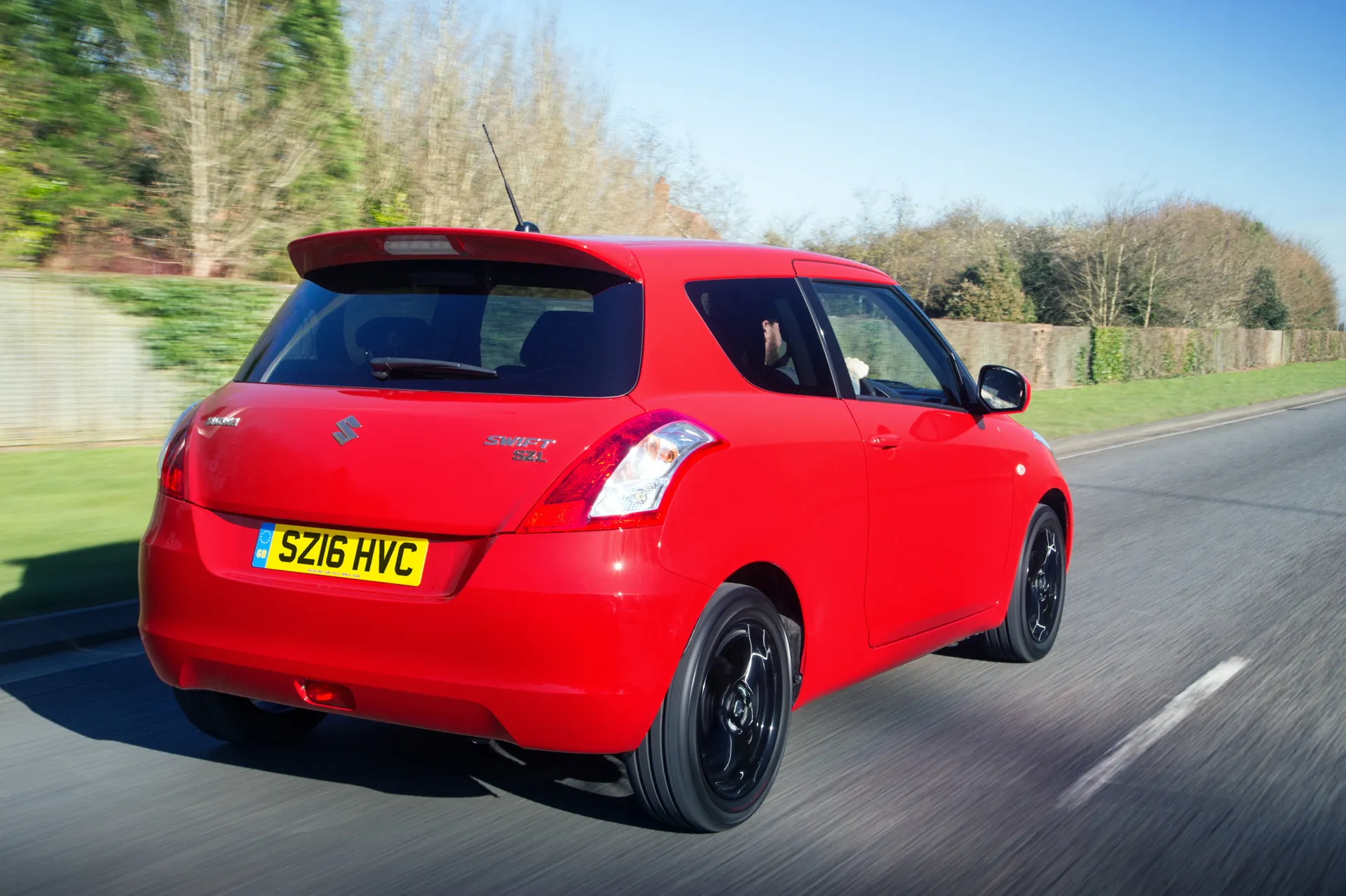
The 1.3-litre DDiS diesel engine offers the best economy, offering a claimed 72.4mpg on a combined cycle. If you spend most of your time in the city, the 1.2-litre petrol could return 56.5mpg, but this drops to 50.4mpg with the automatic transmission. There’s also a penalty of around 5mpg if you drive the Swift 4x4.
The Swift Sport offers a claimed 44.1mpg, but you’ll be having too much fun to get anywhere near this.
Insurance groups and costs
The Suzuki Swift isn’t as cheap to insure as some of its rivals. The group ratings range from nine for a basic 1.2-litre model, to 11 for a Swift in a more desirable trim level. All versions of the 4x4 slot into group 11.
There’s better news if you fancy the Swift Sport, because group 19 is reasonably low for a hot hatchback, albeit one that’s more simmering than flaming hot. That said, many versions of the contemporary Mini Cooper will be cheaper to insure.
VED car tax
Some very late examples of the Swift would have been registered on or after 1 April 2017, around the time Suzuki introduced the current model in the UK. If this is the case, the rate of Vehicle Excise Duty (VED) will be £150 a year.
For the other models, the rate of VED varies according to the car’s CO2 emissions. For example, the Swift launched in 2010 with a 1.2-litre petrol engine producing 116g/km CO2. As a result, you’ll pay £30 a year for road tax.
Opting for the automatic version increases the CO2 emissions to 128g/km, which means a rate of £125 a year. The 1.3-litre diesel is 1g/km short of being tax exempt, so you pay £20 a year.
Predictably, the 4x4 and Sport versions incur the highest rate of VED. You’re looking at £125 for the 4x4 and £165 for the Sport.
How much should you be paying for a used Suzuki Swift?
"The earliest examples of the Suzuki Swift are available for around £2,500. For this budget, you’re looking at a 2011 car with upwards of 100,000 miles on the clock. Pushing the budget to £3,000 will ensure you get your hands on a tidy example with fewer miles."
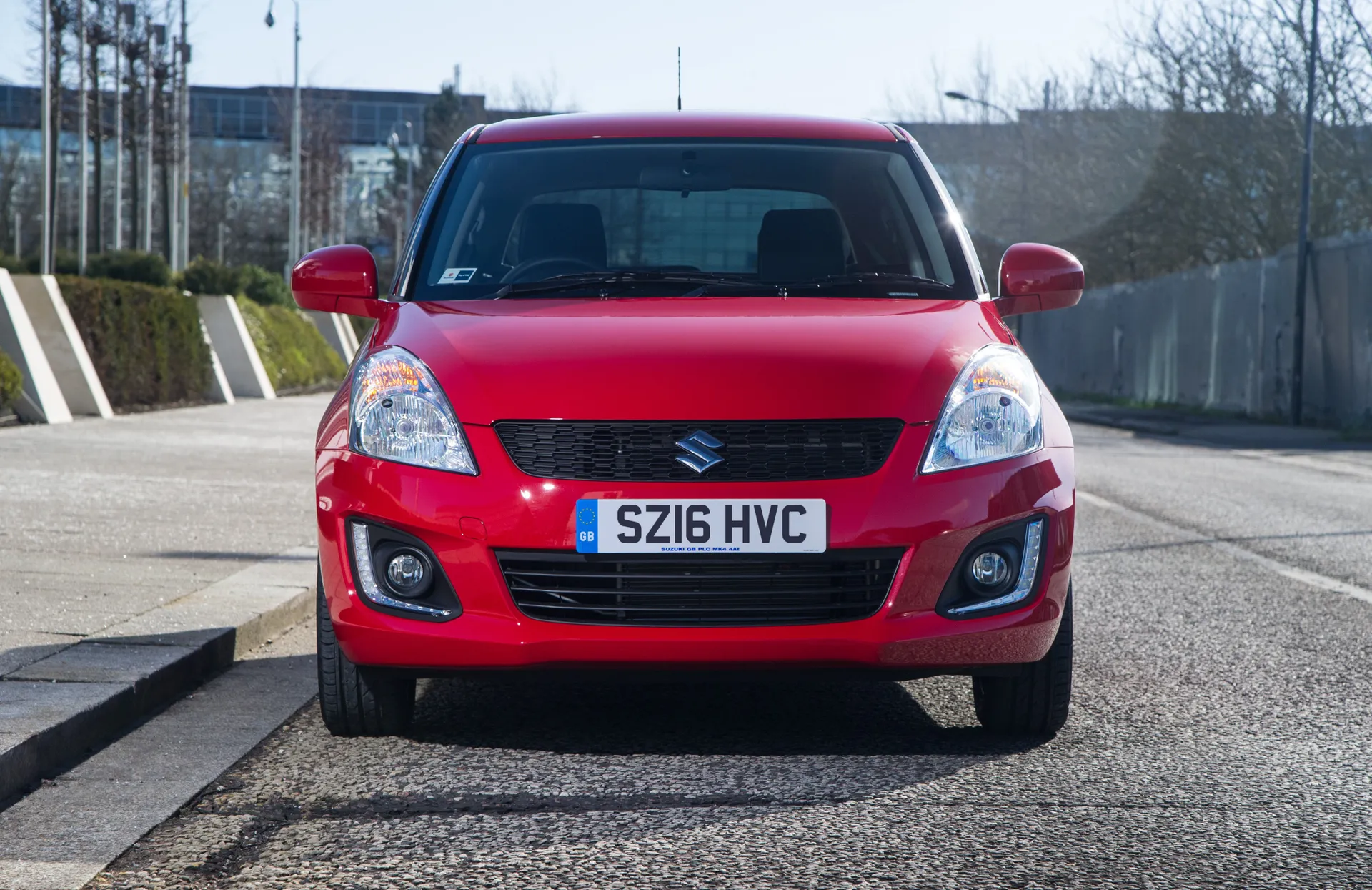
You’ll need to find at least £5,000 for a good example of the brilliant Suzuki Swift Sport. It’s possible to get one for less, but these cars tend to have an insurance category C or D against their name. Our advice would be to opt for a good example of the original Swift Sport, which, whisper this, is actually more fun to drive.
It’s harder to find a Suzuki Swift 4x4, but prices are roughly in line with those of the Swift Sport. The most you’ll pay for a Swift of this generation is £10,000. Some very late examples might be covered by the remainder of Suzuki’s three-year warranty.
Trim levels and standard equipment
The entry-level SZ2 trim launched in 2010 with seven airbags, electronic stability control, remote central locking, electric front windows, radio and CD player, USB port and a leather-trimmed steering wheel with audio controls.
The SZ3 trim added manual air conditioning, 16-inch alloy wheels and the option of an automatic transmission. The flagship SZ4 featured a steering wheel adjustable for height and reach, an engine-start button, cruise control, Bluetooth, automatic headlights, rear privacy glass, front fog lights and automatic air conditioning.
The Swift 4x4 was based on the SZ4 trim, with the added benefit of front and rear skid plates, wheelarch extensions and side skirts. The Swift Sport also featured a range of mechanical and cosmetic upgrades.
Also look out for the SZ-L and Attitude special editions. The latter was based on the SZ3 trim, but with styling that mimicked the Swift Sport.
Get our latest advice, news and offers
Keep me updated by email with the latest advice, news and offers from heycar.
By submitting you agree to our privacy policy



